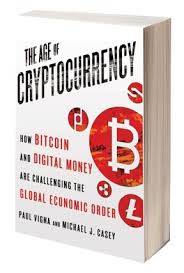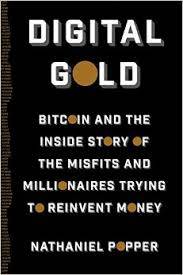The next Champaign-Urbana Bitcoin Meetup is on August 18th. Don’t know anything about Bitcoin? Read on. Our first book review will get you up to speed on Bitcoin technology and the implications of cryptocurrency in our city and our world.
 Two recent books provide important background and insight into the recent development of Bitcoin and other cryptocurrencies. The Age of Cryptocurrency by Paul Vigna and Michael J. Casey and Digital Gold by Nathaniel Popper together constitute essential readings for anyone seriously interested in Bitcoin and related technology. (Left: Bitcoin, image courtesy of www.rt.com)
Two recent books provide important background and insight into the recent development of Bitcoin and other cryptocurrencies. The Age of Cryptocurrency by Paul Vigna and Michael J. Casey and Digital Gold by Nathaniel Popper together constitute essential readings for anyone seriously interested in Bitcoin and related technology. (Left: Bitcoin, image courtesy of www.rt.com)
But the future of cryptocurrency is not a simple case of technological determinism. One of the most interesting thing about cryptocurrency is how it seems to be an ambiguous Rorschach test upon which people project their own hopes and anxieties.
Indeed, cryptocurrency is interesting because of what it does to people. What kinds of communities take shape around this technology?
Origins
Recent years have seen the flowering of cryptocurrencies, which are both technological developments and technologically-enabled communities.
The ur-text for contemporary cryptocurrencies is the “Satoshi Nakamoto” paper, which is part computer science manual and part hard money manifesto.
This document describes a nascent Bitcoin, which has since become the most widely known and used cryptocurrency. The paper also founded the Bitcoin community, a world-wide, digitally-connected group of enthusiasts, engineers, entrepreneurs, and others.
 Perhaps the most interesting aspect of these cryptocurrency communities is that they are organized in part as small digital subcultures, each with its own narrative and participatory theater. They enact stories about not only technology but also money, identity, and power — perennial concerns for any culture. (Right: Bitcoin accepted here signs, image courtesy of siliconangle.com)
Perhaps the most interesting aspect of these cryptocurrency communities is that they are organized in part as small digital subcultures, each with its own narrative and participatory theater. They enact stories about not only technology but also money, identity, and power — perennial concerns for any culture. (Right: Bitcoin accepted here signs, image courtesy of siliconangle.com)
Even Bitcoin itself has developed more than a half dozen sub-communities, each with a different and competing narrative about the significance and principle uses of the exact same technological complex.
As with every culture, there isn’t one single “story” of cryptocurrency. Like conventional money, cryptocurrency carries significant meaning beyond its bare technical specifications. The crux of these cryptocurrency “narratives” are beliefs and stories about economics and politics, community, power, and identity.
We don’t know a great deal about the communities that grow around cryptocurrency. Digital communities are fundamentally difficult to study, and both methods and theories are undeveloped.
A few new books aim to change this by providing a solid foundation for understanding cryptocurrency’s first years and where it might take us in the future.
Cryptocurrency, 2009-Present
 The Age of Cryptocurrency by Paul Vigna and Michael J. Casey
The Age of Cryptocurrency by Paul Vigna and Michael J. Casey
Wall Street Journal reporters Vigna and Casey have put together a very good book, which will be an essential reading for anyone wanting to actually understand the first few years of cryptocurrency. I found myself disagreeing with some of the points in this book, but it is the most comprehensive review of these issues I’ve seen, and avoids the crazy rhetoric of the most enthusiastic boosters and detractors.
Most important of all, they are deeply aware that this is a cultural story, built on, but not driven by, technology.
The book balances technology and people by both explaining the technical basics and providing a solid history of the people and organizations who have contributed to the “age of cryptocurrency” in which we find ourselves.
They also give useful foundations for the major policy and legal issues which will play out in the next few years.
List of Chapters in “The Age of Cryptocurrency”
- History
- echnical Genesis
- Community
- Revolutionizing Electronic Payments
- The Blockchain
- Arms Race
- Enterprise
- The Unbanked
- The Everything Blockchain
- Governance
- Yet Another New Economy
Overall, Vigna and Casey have a rather positive view of cryptocurrency and Bitcoin. Wall Street Journal writers have definite views on political economics, which plays out in numerous ways. The whole book should be read against the background of their statement of faith: “All else being equal, technological disruption makes an economy more efficient and creates more wealth overall.” (p.5)
One thing is very clear: they totally get the cultural aspect of cryptocurrencies. For example, they correctly cite Dogecoin as an important phenomenon, and for the right reasons: it created a specific community committed to a unique, participatory culture.
In Chapter 12, Vigna and Casey step back to look at the bigger picture. They remind us that Bitcoin is tiny in comparison to the world economy, and deeply connected with antisocial activities, drugs, porn, guns, extortion, and fraud; stuff that most people do not want to be associated with. Bitcoin’s economic model is bad macroeconomics, and undermines good economics. There is a very good reason we left behind the gold standard, and only the ignorant seriously want its return.
Finally, Vigan and Casey hitch up their trousers and have the courage to think seriously about six possible futures, each believable in ten or twenty years. I will list them here, and urge you to read the chapter to get the details.
- The “No” Case
- The “Yes” Case
- A Vital, if Unseen Cog
- The Multicoin World
- The Digital Dollar
- Bretton Woods II
 Digital Gold by Nathaniel Popper
Digital Gold by Nathaniel Popper
Nathaniel Popper writes for the New York Times, and this book is a piece of long-form journalism.
Like Vigna and Casey, he is also interested in the people that grant value to Bitcoin. He focuses on the stories of the people involved in the Bitcoin community, their motivations and relationships. Based on journalistic research and personal interviews, the result is relatively light on technical discussion and very heavy on the inside stories of business development.
The book gives us some insight into the various sub-communities surrounding Bitcoin. Through detailed biographies of key people, we meet the technologists, the libertarians, the venture capital crowd. We also see the bumbling, ramshackle early innovators, the alternative perspectives from Argentina and China. And we witness their blatant misbehavior and outright criminality.
Popper chooses to tell the story of this community through the eyes of “great men” (and yes, they are all men). “The community” to him means these big shots who gather at (and invite him to) their posh private resorts. The main exception to this pattern is the brief mention of the programmers who contributed so much for little, if any, payment. (Side note: I’m pretty sure that this acknowledgement came via Gavin Andresen, who is a straight up guy, and not interested in being the poster child representing the whole open source software project.)
In addition to this “great men” history, Popper tries to impose a narrative arc on what is an organic and chaotic set of events. If you only knew what appears in this book, you would be under the impression that Bitcoin was progressing, apparently naturally, from an infantile libertarian, “hobbyist” project, through an adolescent “fringe users” (such as drugs and gambling), to adulthood in the financial elite. He also perceives a “Silicon Valley versus Wall Street” contest, which is part of the larger “blame it on California” narrative that is so salient to New Yorkers, if not to the rest of us.
Popper perceives that there are many “narratives” built around Bitcoin, and they are inconsistent, incompatible, and even in conflict,
But I think it is clear enough that there is no “arc of history”: cryptocurrency is heading in many directions at once, driven by technical, political, economic, and, above all, social factors.
Recommended readings and references
Want to learn about about Bitcoin? Take a look at some of these texts (one of which — shameless plug — was written by a local author).
- Jeremiah Bohr and Masooda Bashir. Who Uses Bitcoin? An exploration of the Bitcoin community. In Privacy, Security and Trust (PST), 2014 Twelfth Annual International Conference on, 2014, 94-101. http://ieeexplore.ieee.org/xpl/articleDetails.jsp?arnumber=6890928
- Robert McGrath, You Shall Not Crucify The Internet On This Cross of Bitcoin, in Very Much Wow. 2014: Albuquerque. p. 34-37. http://issuu.com/verymuchwow/docs/vmw3/35?e=11558635/8421855.
- Nathaniel Popper,, Digital Gold: Bitcoin And The Inside Story of The Misfits and Millionaires Trying to Reinvent Money, New York, HarperCollins, 2015. http://www.harpercollins.com/9780062362490/digital-gold
- Paul Vigna and Michael J. Casey, The Age of Cryptocurrency: How Bitcoin and Digital Money Are Challenging the Global Economic Order, New York, St Martin’s Press, 2015. http://theageofcryptocurrency.com/
Robert E. McGrath has been writing about sociotechnical perspectives on cryptocurrencies since 2013. He is organizing a local multidisciplinary cryptocurrency study group.








